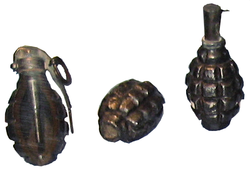| F1 grenade | |
|---|---|
 From left to right: F1 with M1916 Billant fuse, F1 body, F1 with percussion fuse. | |
| Type | Percussion, then time-fused grenade |
| Place of origin |
|
| Service history | |
| In service | 1915–1940[1] |
| Used by | France, United States of America, Finland |
| Wars | World War I and World War II |
| Production history | |
| Designed | 1915 |
| Produced | 1915– |
| Specifications | |
| Mass | 570 g[2] |
| Length | 90 mm (without fuse) |
|
| |
| Filling | Cheddite (World War I model) |
| Filling weight | 60 gr |
Detonation mechanism | Timed Friction Fuse |
The F1 grenade is a hand grenade used by France during World War I and World War II.
Overview[]

F1 grenade with the percussion fuse.
The F1 was a grenade designed during World War I and used by French infantrymen at the time. Originally, the F1 was designed to use a lighter-based ignition system, but later it began using a percussion cap fuse. Designs such as the M1916 and M1917 Billant fuses turned the F1 into a time-fused grenade, which was the grenade's final ignition system. By World War II, the F1 used the M1935 fuse, which is a time-based fuse, but it differs the M1916 Billant fuse internally.
The F1 was used up to World War II, where it served as France's primary fragmentation grenade. The French also used P1 grenades and Citron foug grenades. After the war, the F1 grenade was withdrawn from service.
Use[]
In addition to the French, several other forces used the F1.
United States[]
The F1 with the M1916 Billant fuse was the preferred grenade by American forces during World War I. The F1 is the inspiration behind the failed American Mk 1 grenade, which in turn spawned the iconic Mk 2 grenade.
Russian Civil War[]
During the Russian Civil War, the F1 was given to the White Movement forces by France. After the civil war, the French F1 design was modified into the Russian F1 grenade design.[3][better source needed]
See also[]
References[]
- ↑ Bernard Plumier (2004-03-29). "Passion & Compassion 1914-1918 : WW1 militaria and technical documentation - french grenades". Passioncompassion1418.com. http://www.passioncompassion1418.com/decouvertes/english_grenades_fr.html. Retrieved 2012-09-18.
- ↑ "Finnish Junkyard". Saunalahti.fi. http://www.saunalahti.fi/~junkyard/grenades.html. Retrieved 2012-09-18.
- ↑ "Pics Russian F1 War Time Grenade?? Possible French F1?? at War relics forum". Warrelics.eu. http://warrelics.eu/forum/firearms-ordnance/pics-russian-f1-war-time-grenade-possible-french-f1-7329/#post50458. Retrieved 2012-09-18.
External links[]
| |||||||||||||||||||||||
| |||||||||||||||||||||||
The original article can be found at F1 grenade (France) and the edit history here.